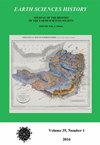阿尔伯特·柯的九头蛇:一场骗局还是一堆真正的骨头
IF 0.6
4区 哲学
Q4 GEOSCIENCES, MULTIDISCIPLINARY
引用次数: 0
摘要
这是关于阿尔伯特·科赫生平和收藏活动的两部分系列文章的第二篇。科赫前往英国,在那里他将自己的密苏里州卖给了大英博物馆,这是一只现在矗立在伦敦自然历史博物馆的美国乳齿象,然后他回到了自己的祖国德国。科赫离开了德累斯顿的家人,再次前往美国进行一些额外的古生物学冒险。经过几周的旅行,他抵达阿拉巴马州,在那里他挖掘了一头大型古鲸的遗骸,并将其命名为Hydrarchos。科赫在将其带到欧洲之前,在纽约和其他几个东部城市展出了这具骨架。在柏林时,科赫将这具骨架卖给了普鲁士国王弗里德里希·威廉四世,后者将其收藏在皇家博物馆。不久之后,科赫返回美国和阿拉巴马州,发现了第二具鲸鱼骨架。他把这具骨架带到了欧洲,在几个城市展出,但由于没有收到任何报价,科赫带着他的第二具九头蛇回到了美国,最初在新奥尔良展出,后来在圣路易斯展出,最后在芝加哥展出。晚年,科赫将注意力转向圣路易斯科学院,在那里他成为了一名活跃的成员和策展人,也是一名矿产勘探者。这篇文章探讨了科赫生命的最后几章,以及他的创业表演倾向与他对科学的贡献。这篇叙述是发表在《地球科学史》第41卷第2期的一篇文章的续集,该文章聚焦于阿尔伯特·科赫的密苏里州。这两篇文章共同记录了阿尔伯特·C·科赫的生活和职业生涯。本文章由计算机程序翻译,如有差异,请以英文原文为准。
ALBERT KOCH’S HYDRARCHOS: A HOAX OR A BONA FIDE COLLECTION OF BONES
This is the second essay of a two-part series on the life and collecting activities of Albert Koch. After Koch traveled to England where he sold his Missourium to the British Museum, the American mastodon that now stands in the Natural History Museum of London, he then went to his homeland in Germany. Koch left his family in Dresden, when he again departed for the United States to pursue some additional paleontological adventures. Following several weeks of travel, he arrived in Alabama where he excavated the remains of a large, archaeocete whale, that he named the Hydrarchos. Koch displayed the skeleton in New York, and several other eastern cities before taking it to Europe. When in Berlin, Koch was able to sell the skeleton to King Friedrich Wilhelm IV of Prussia who placed it in the Royal Museum. Soon thereafter, Koch returned to the United States and Alabama to discover a second whale skeleton. He took this skeleton to Europe where it was exhibited in several cities but, having received no offers, Koch returned with his second Hydrarchos to the United States where it was initially displayed in New Orleans, then St. Louis, and eventually Chicago. In his later years, Koch turned his attention to the Academy of Science of St. Louis where he became an active member and curator, as well as a prospector for minerals. This essay examines the final chapters of Koch’s life and his entrepreneurial showmanship tendencies versus contributions he may have made to science. This narrative is a sequel to an article published in Volume 41 Number 2 of Earth Sciences History that focused on Albert Koch’s Missourium. Together, the two essays capture the life and career of Albert C. Koch.
求助全文
通过发布文献求助,成功后即可免费获取论文全文。
去求助
来源期刊

Earth Sciences History
GEOSCIENCES, MULTIDISCIPLINARY-HISTORY & PHILOSOPHY OF SCIENCE
CiteScore
1.00
自引率
0.00%
发文量
1
审稿时长
>12 weeks
期刊介绍:
Earth Sciences History promotes and publishes historical work on all areas of the earth sciences – including geology, geography, geophysics, oceanography, paleontology, meteorology, and climatology.
The journal honors and encourages a variety of approaches to historical study: biography, history of ideas, social history, and histories of institutions, organizations, and techniques.
Articles are peer reviewed.
 求助内容:
求助内容: 应助结果提醒方式:
应助结果提醒方式:


